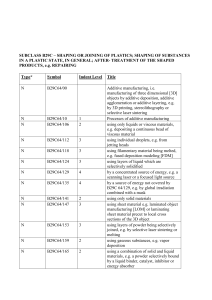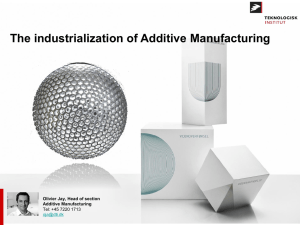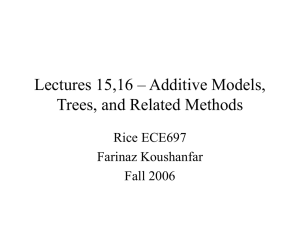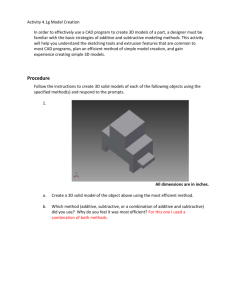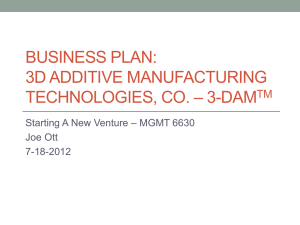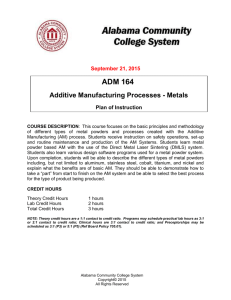ratna - University of Leicester
advertisement
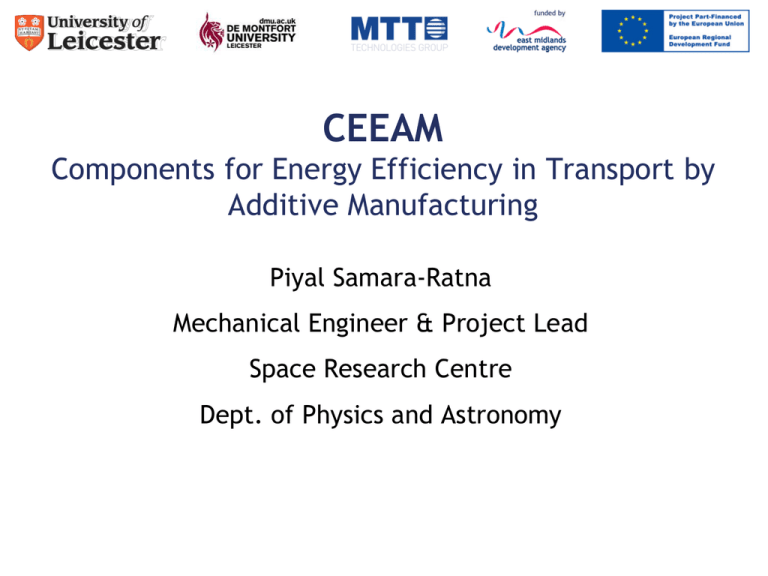
CEEAM Components for Energy Efficiency in Transport by Additive Manufacturing Piyal Samara-Ratna Mechanical Engineer & Project Lead Space Research Centre Dept. of Physics and Astronomy Project Overview • Funding by the Transport iNet • 18 month project – Started September 2010 • Collaboration: – Space Research Centre – Mechanics of Materials Group at Leicester University – Additive Manufacturing group at DMU – MTT (industrial collaborator) • Project objectives: – Bring additive manufacturing into Space and other commercial markets for regional benefit – 4 businesses engaged with collaborations with HEIs – 4 businesses assisted to improve performance – 1 job safeguarded – 6 graduates employed and 1 assisted in STEM training What is Additive Manufacturing? Conventional Machining Additive Manufacturing Additive manufacturing now available to manufacture components in metal Benefits of Additive Manufacturing • No limit to complexity of parts • No time/cost penalty for complexity • No additional tooling costs • Minimal wastage: – All excess material can be recycled and reused immediately – Potential to be extremely environmentally friendly • It’s a process that encourages the engineer to make the component as efficient as possible • It enables engineers to manufacture products that were simply never possible – High performance lattice structures Space Research Centre (SRC) • The Space Research Centre needs to adopt innovative manufacturing techniques to remain competitive in building space instrumentation: – Technology improvements are driving tougher design requirements – The SRC needs to produce real hardware that works – We also need to prove to our customers that it works • Facilities to be a customer and technology developer for additive manufacturing • Current SRC portfolio highlights: – 3 instruments on the future ESA Mars Rover – 1 Instrument on the replacement to Hubble Space Telescope – 1 instrument on a mission to Mercury – Development of nuclear power systems for future spacecraft The Problem? • High Production costs – Appropriate for the low volume manufacture – Technology still needs development before it is suitable for mass volume production • Lack of process control – Uncertainty in ensuring that parts have no defects – Risk of high financial losses if parts do not meet the build standard • Lack of material properties for parts produced using additive manufacturing: – The process dictates the material properties – Each machine will need to be certified The Solution! • Development of an in-process monitoring system: – Ensures the quality of the parts – Ability to stop/alter the process – Developed primarily between DMU and MTT (additive manufacturing machine supplier) • Development of materials qualification process: – Developed primarily between Space Research Centre and the Mechanics of Materials Group – Developed to international space standards • Mechanical and thermal testing • Qualification initially for titanium (Ti64AV) and then expanded to other materials (e.g. Stainless steel) Process Chain Evaluation Part Design Raw material handling Machine Setup Part Production Part postprocessing Integration to end application • Removal of support structure •Heat treatment • Surface finish • Drilling/tapping • Interfacing • Bonding • Part monitoring • Maintenance Concept to Production Process Chain Designing parts to fit the manufacturing process • Specification • Grade • Purity • Approved suppliers • Handling • Storage • Machine qualification • Setup procedure • Calibration • Process settings • Environmental settings • Build orientation • Process monitoring • Quality assurance Industry Collaboration • Currently working with 11 industrial collaborators in Motorsport, automotive, aerospace, manufacturing, rail and dental • Promote technology by development of sample parts for each industrial sector • Free training & Free sample parts enables: – Promotional technology demonstrators – Tools to generate interest amongst industrial partner customer base • SRC to provide engineering effort: – CAD design facilities – Analysis data to support: • Mechanical • Thermal • CFD • Technology development covered by NDA Summary • By making real working hardware the SRC bridges the gap between research and commercial industry • The SRC is paving the way for innovative manufacturing like Additive Manufacturing to be used in commercial sectors: – Proving it to work in harsh test environments – Tackling issues preventing uptake of technology • Benefits for the SRC: – Development of knowledge and experience – Fulfils obligation of the University to support the region – Opens the door to possible future research collaborations • Benefits for industry: – Low investment in new technology – Publicity of using innovative technology used on space instrumentation – Long-term establishment of regional research expertise
